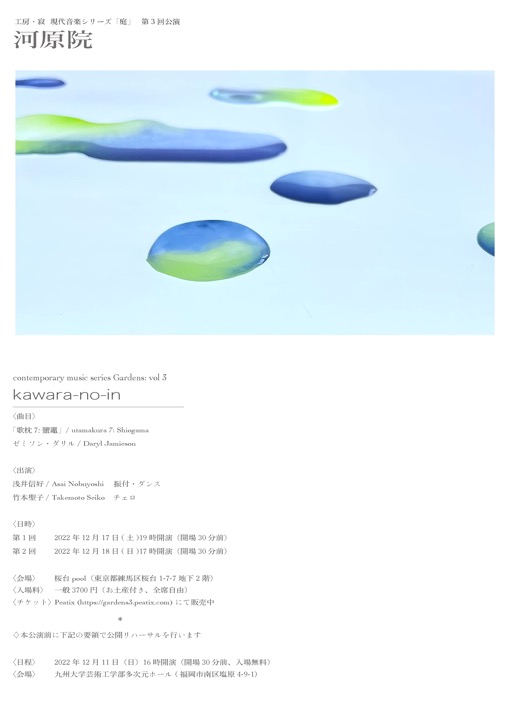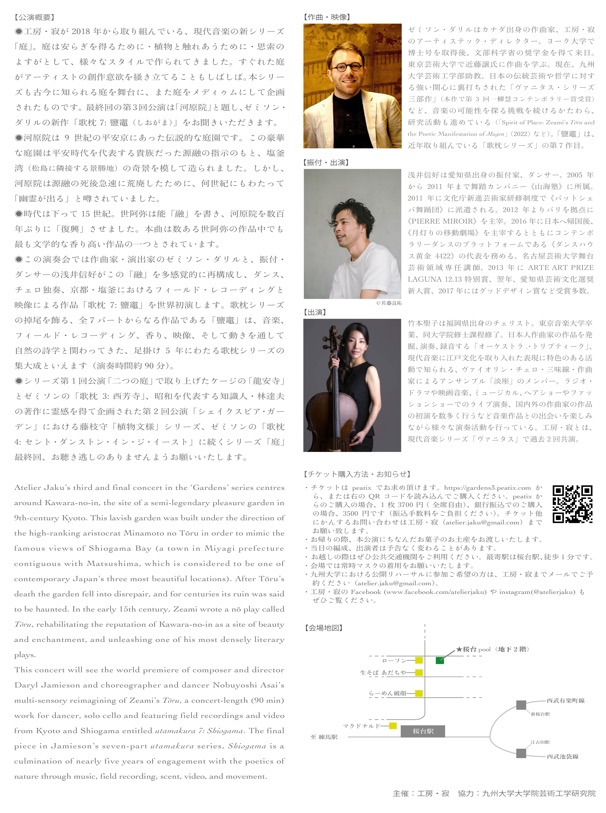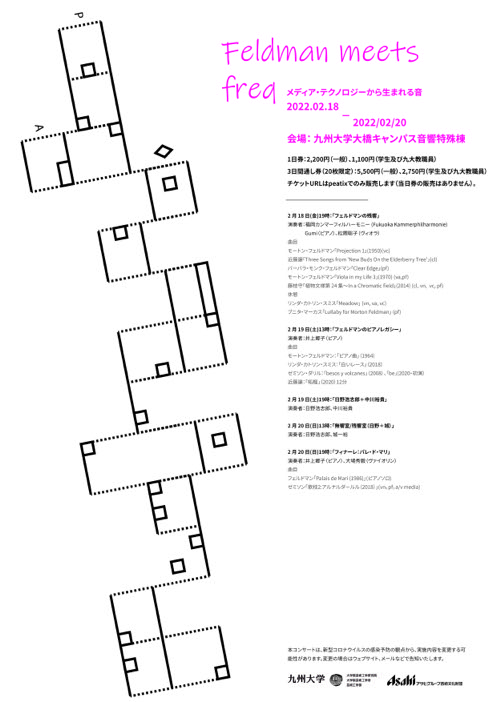2022年12月17日〜18日 チェロとダンサーのための「歌枕7: 鹽竈」
04/11/22
工房・寂では、2022年12月17日、18日に東京で開催する2回の演奏会で、私の歌枕シリーズの最新作「歌枕7: 鹽竈」を初演する予定です。また、2022年12月11日には福岡で無料のワークショップ公演を開催します。詳細は工房・寂のホームページをご覧ください。また、Peatixでの東京演奏のチケット購入はこちらです。




2022年9月17日 ピアノのための「露」
12/09/22
金春禅竹の美学に関する私自身の研究から得たインスピレーションを基に作った、70分間に及ぶピアノソロのための曲「露」を、ピアニストのシェリル・デュヴァルが、9月17日(土)20時からトロントにあるカナダミュージックセンターで世界初演します。
チケットはカナダミュージックセンターから購入できます。
トロントにいない方は、ユーチューブでライブストリームを観ます。ライブストリーミングは日本時間 9月18日(日)朝9時に開始します。

チケットはカナダミュージックセンターから購入できます。
トロントにいない方は、ユーチューブでライブストリームを観ます。ライブストリーミングは日本時間 9月18日(日)朝9時に開始します。

2022年3月15日:パリのIRCAMで「笙と竽」を発表する
11/03/22
笙と竽:石川高との10年にわたるコラボレーションを通じての、物理的・ジャンル的可能性の探究
2022年3月15日、パリのIRCAM(オンライン)で、笙と竽のために書いた私の作品についてのレクチャーを行います。私のレクチャーの後には、音楽学者フランソワ=グザヴィエ・フェロン氏による笙(竽)、ヴィオラ、チェロのための私の作品「フォーリングス」 (2016年) を分析するレクチャーが続きます。私の講義は英語、フェロンの講義はフランス語で発表されます。
講演は、YouTubeでご覧ください。IRCAMのウェブページもこちらに見えます。
私の作曲した笙と竽のための作品(ソロまたは室内楽)は以下の通り:
「スペクトル−大野一雄氏に寄せて」 (2012年)
「落ちてきた断片」 (2015年)
「フォーリングス」 (2016年)
「ストラヴェイグ」 (2017年)
「デスカント第1番」 (2020年)
下の画像をクリックすると、全ページのPDFがご覧いただけます。
Programme séminaire 13_15.03.2022
2022年3月15日、パリのIRCAM(オンライン)で、笙と竽のために書いた私の作品についてのレクチャーを行います。私のレクチャーの後には、音楽学者フランソワ=グザヴィエ・フェロン氏による笙(竽)、ヴィオラ、チェロのための私の作品「フォーリングス」 (2016年) を分析するレクチャーが続きます。私の講義は英語、フェロンの講義はフランス語で発表されます。
講演は、YouTubeでご覧ください。IRCAMのウェブページもこちらに見えます。
私の作曲した笙と竽のための作品(ソロまたは室内楽)は以下の通り:
「スペクトル−大野一雄氏に寄せて」 (2012年)
「落ちてきた断片」 (2015年)
「フォーリングス」 (2016年)
「ストラヴェイグ」 (2017年)
「デスカント第1番」 (2020年)
下の画像をクリックすると、全ページのPDFがご覧いただけます。
Programme séminaire 13_15.03.2022
Feldman meets freq
11/02/22
2月18日~20日、九大芸術工学部音響特殊棟で5つの演奏会を催します。Feldman meets freqという一連の演奏会は、フェルドマン(と周りの作曲家)に影響を受けた福岡在の音楽家にフォーカスします。
助成:アサヒグループ芸術文化財団,科研費 二つの文化の接点としての音を聴取する体験の設計 [19K21615]


助成:アサヒグループ芸術文化財団,科研費 二つの文化の接点としての音を聴取する体験の設計 [19K21615]


ソマシキバ
27/02/21
角田俊也の「ソマシキバ」(2016年)を、京都学派の上田閑照の美学、及び高橋睦郎の詩学に由来する解釈手法を用いて分析した論文「Field Recording and the Re-enchantment of the World」が『Journal of Aesthetics and Art Criticism』に発表されました。
Nonfictional field recording is a genre of music (sound art) which offers a glimpse of art beyond our late-capitalist age. The ongoing ecocide which we, in a state of abject detachment, are witnessing and abetting calls out for artists to reconnect and reengage with the nonhuman world that has been deemed valueless by our civilization. Countering the disenchantment of nature wrought by scientism, human-centrism, and above all capitalism necessitates a dissolving of the barriers we set up between ourselves and our environment, a task which can be only accomplished via religion or art: an art—like field recording—which affords reconnecting its audience with the enchantment of the ignored world surrounding them.
In this article, Toshiya Tsunoda’s exemplary Somashikiba (2016)—recorded in locations forgotten by civilization—will be examined via interpretive tools adapted from Ueda Shizuteru’s Kyoto School aesthetics and Takahashi Mutsuo’s poetics. Ueda’s philosophy offers a way of understanding perception which eliminates the subject-object division. Takahashi’s project of recovering the spirituality of place through poetry is a model of historically and politically engaged art. Looking, as these contemporary Japanese thinkers have done, to the precapitalist, pre-formalist past to rediscover (sound) art’s function as a medium which reconfigures the listener’s perception of reality, I argue for the urgency of sound art such as Tsunoda’s which aids in the re-enchantment of the world to a future beyond capitalist, humanist “civilization.”
Keywords: field recording, Toshiya Tsunoda, nature, Japanese aesthetics, ecoaesthetics, Buddhist philosophy, Ueda Shizuteru, sound art, aesthetics of sound, Takahashi Mutsuo
Abstract:
Nonfictional field recording is a genre of music (sound art) which offers a glimpse of art beyond our late-capitalist age. The ongoing ecocide which we, in a state of abject detachment, are witnessing and abetting calls out for artists to reconnect and reengage with the nonhuman world that has been deemed valueless by our civilization. Countering the disenchantment of nature wrought by scientism, human-centrism, and above all capitalism necessitates a dissolving of the barriers we set up between ourselves and our environment, a task which can be only accomplished via religion or art: an art—like field recording—which affords reconnecting its audience with the enchantment of the ignored world surrounding them.
In this article, Toshiya Tsunoda’s exemplary Somashikiba (2016)—recorded in locations forgotten by civilization—will be examined via interpretive tools adapted from Ueda Shizuteru’s Kyoto School aesthetics and Takahashi Mutsuo’s poetics. Ueda’s philosophy offers a way of understanding perception which eliminates the subject-object division. Takahashi’s project of recovering the spirituality of place through poetry is a model of historically and politically engaged art. Looking, as these contemporary Japanese thinkers have done, to the precapitalist, pre-formalist past to rediscover (sound) art’s function as a medium which reconfigures the listener’s perception of reality, I argue for the urgency of sound art such as Tsunoda’s which aids in the re-enchantment of the world to a future beyond capitalist, humanist “civilization.”
Keywords: field recording, Toshiya Tsunoda, nature, Japanese aesthetics, ecoaesthetics, Buddhist philosophy, Ueda Shizuteru, sound art, aesthetics of sound, Takahashi Mutsuo